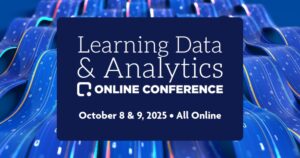By Alaina Szlachta
“Stakeholders don’t know whether HR and L&D are worth investing in.”
This candid statement from a good friend, and fellow learning enthusiast, captures a central challenge L&D professionals have faced for decades. Many organizational leaders struggle to see the direct connection between learning initiatives and business outcomes. When budgets tighten, HR and L&D departments are often first on the chopping block—precisely because this connection remains unclear.
In my research and work as an internal learning leader and consultant, I’ve consistently found that alignment is the single factor that differentiates high-performing, mature learning departments from everyone else. As Ingrid Guerra-Lopez wisely notes, “The value of alignment is not in achieving perfection, but having habits and processes in place to make striving for alignment an ongoing practice.”
In this article, I’ll share three powerful alignment tactics I regularly apply in my work that can help us all incrementally move from being a cost center to a strategic organizational asset.
The starting point: Misalignment & missed opportunities
Many learning departments struggle with relevance and with keeping pace with the ever-changing needs and priorities of their business. Additionally, the learning function in the average organization often boasts high learning satisfaction scores, yet participants rarely apply what they learn back on the job.
This disconnect perpetuates the cost-center narrative, due to wasted resources on unused learning, missed opportunities to develop critical capabilities, and growing frustration from business leaders who see learning as a compliance necessity rather than a strategic advantage. To interrupt this cost-center narrative and improve our learning team’s relevance and overall contribution to the organization, we can lean on three simple yet powerful alignment tactics.
Tactic #1: Aligning with core learning value propositions
While you may know Robert Brinkerhoff for being the brain behind the Success Case measurement methodology, he also co-created an equally useful framework, the 6 Learning Value Propositions. In this framework, he posits that all the varieties of training, learning, and development we create can be categorized into one the following buckets of value.
- Supporting job performance: Helping employees perform effectively on the job.
- Providing a talent pipeline: Building competencies to enable a smoother succession of internal employees into higher roles.
- New strategy execution: Nurturing workplace behaviors to facilitate organizational change and strategies.
- Emergency performance: Preparing staff to respond to emergency situations, prioritizing safety and damage control.
- Regulatory requirements: Ensuring personnel are compliant with industry-specific rules and regulations.
- Staff benefits: Providing access to learning and growth opportunities as a competitive employee advantage.
Anytime I take on a new learning initiative, I first identify which of the six value propositions my initiative aligns with. The benefit of this exercise is creating a common language to speak with my team and stakeholders about the value associated with our investment in learning.
If you are one of the many people who feel like sourcing the business goals and metrics associated with training is like pulling teeth—a very painful process. You’ll be relieved to know that this framework is also very useful to help you easily align your learning initiatives with strategic organizational outcomes—without even asking stakeholders for their input (that comes later).
In Dr. Will Thalheimer’s latest book, The CEO’s Guide to Training, eLearning, and Work, he emphasizes how the learning function (when grounded in the core principles of learning science) actually contributes to the organization’s competitive advantage. Describing the value of our learning initiatives using language that business leaders understand helps us to break out of the historical silos that the learning function often finds itself in. Yet, we must take this alignment tactic one step further to get the full advantage of Brinkerhoff and Brittan-Catlin’s learning value propositions.
Next, we must connect the value proposition for our new learning initiative to specific metrics that matter most to stakeholders. While we could argue there are many metrics that business leaders care about, I believe there are only a handful of organizational metrics that we can or should align our initiatives to.
While data is an incredible asset for guiding our investments in learning, more data is not always more valuable. Below are the organizational metrics that are most relevant for each of our Learning Value Propositions.
- Supporting job performance: revenue and mission fulfillment
- Providing a talent pipeline: employee retention and net profit
- New strategy execution: revenue, mission fulfillment, and market share
- Emergency performance: net profit
- Regulatory requirements: net profit
- Staff benefits: employee retention
Here’s an example of what this alignment tactic might look like in practice. I like to create a sentence that connects the learning initiative to the most relevant learning value proposition and to the most appropriate organizational metric(s). This sentence is then something I present to my learning team and stakeholders and ask for their reaction. This doesn’t need to be a formal presentation. You can simply send your statement in an email and ask if you’ve captured the desired outcomes of the program correctly (or not), and what they’d like you to change before you dive more into the development process.
Example statement: The purpose of our customer service onboarding program is to support job performance, helping our customer service team to perform effectively on the job (insert appropriate key performance indicators if you already know the key performance indicators the team should be accomplishing) and sustain or improve the team’s contribution to organizational revenue.
This simple alignment exercise changes our conversations with stakeholders. Instead of talking about inputs and outputs of learning, that are all costs to the organization, such as time spent in learning, learning completion rates, and satisfaction scores, we started discussing the outcomes and results of learning that contributed to business metrics they cared about.
When you apply this exercise to your list of current learning initiatives, if you find initiatives that are difficult to align with one learning value proposition and the corresponding organizational metrics, it might be an initiative that is costing more to the organization than it contributes.
Tactic #2: Creating alignment through strategic use of data
According to a recent Forbes article describing the value of data literacy and using data to make informed decisions, the benefits for organizations include:
- A common language among teams and departments
- Increased collaboration
- Increased curiosity, creativity, and innovation
- Cost savings
These outcomes explain why data literacy distinguishes high-performing, mature organizations from the rest. Organizations that are data literate and consistently use data to make informed decisions are more aligned. Department leaders are aligned. Communication is aligned, and fewer information silos exist. Employee performance is aligned with KPIs. Learning opportunities are aligned with employee and operational performance gaps. Alignment strengthens the contribution L&D makes to the business and individual employees.
Thus, the next tactic we can apply to improve the relevance and value of our learning function is to translate our data into value. While being data literate can mean many things, in its simplest form, data literacy is the ability to use data to make strategic decisions, while being confident that your data is trustworthy (aka accurate). There are two data practices I use regularly to help me translate my data into value.
Thoughtful data sourcing
Where do you go to get data and insights on the needs and priorities of department leaders? I’ve found that building relationships (or even a team) of inter-departmental leaders is essential to ensure that my sources of data on people problems and opportunities are trustworthy. Before designing any program, I ensure my team partners with the relevant department leaders to understand their needs and priorities.
Building surveys that provide actionable insights
I believe survey fatigue is the direct result of poor survey design. If the surveys we create don’t provide data we can use to take action, they are totally useless. One question has really helped me to refine (and shorten) my surveys. This is not a question we include in our surveys, it is a question we ask for each of the survey questions we create. Pick any multiple-choice question in your survey. Then, imagine that 50% of respondents answered option A. What does that tell you? How will you use this information to improve our program? If the insights you get from this exercise don’t yield actionable insights, either eliminate the question or change it!
Tactic #3: Aligning expectations from the start
Perhaps the most significant change we can make to boost learning alignment is changing how we respond to training requests. This approach is something I learned from my good friend and colleague, Chris Taylor, founder of Actionable.io. Chris suggests that instead of immediately saying “yes” to every request, we say “Yes I’d love to help, and… Can I ask you a couple of questions to kick off the project?”
- “What do you expect will change after participants complete this program?”
- “How are the behaviors you want to change aligned with strategic priorities?”
- “What is the fastest way to facilitate this change?”
This approach to responding to training requests often reveals that that training isn’t always the best solution. In some cases, job aids, mentoring, or workplace environment changes proved more effective. This approach also reveals if our stakeholders really want to invest in behavior change, or if they simply need information to be distributed for compliance purposes. This perspective helps us to invest the proper resources in our initiatives – as information distribution and compliance programs require far less resources than behavior change initiatives.
Conclusion & critical action steps
Alignment isn’t a one-time effort but an ongoing process requiring constant attention and adaptation. By implementing these three alignment tactics, learning professionals can transform how their organizations view and value learning. Instead of being seen as a necessary expense, learning becomes recognized as what it truly is—a strategic asset driving organizational performance and success. The action steps below will help you experience the alignment advantage for yourself!
Aligning with core learning value propositions:
- Map each learning program to one of the six value propositions
- Identify which business metrics each value proposition impacts
- Communicate your learning value proposition to your team and stakeholders and ask them to confirm you’ve accurately captured the results and value the program should provide to the organization
- Develop processes to maintain alignment as business priorities shift
Creating alignment through strategic use of data:
- Foster cross-functional collaboration when designing learning solutions
- Refine measurement approaches to generate actionable insights
- Implement data triangulation to verify learning outcomes
- Build data literacy skills across your learning team
Aligning expectations from the start:
- Determine if behavior change matters to the stakeholder
- Explore alternative solutions beyond traditional training
- Set realistic expectations about resources needed for behavior change
Join us at the Learning Leadership Conference & explore data in L&D
Don’t miss Alaina Szlachta’s session, Align Your Learning Strategy with Business Goals, a hands-on 90-minute mastery session—and dozens of other sessions and activities addressing data in L&D, strategic alignment, and much more! The Learning Leadership Conference is October 1-3, 2025, in Orlando Florida. Register today!
Image credit: Anagramm










